State of Cloud Services Report
VerifiedAdded on 2019/09/16
|14
|3760
|76
Report
AI Summary
This report provides a comprehensive overview of the state of cloud services in the IT industry. It begins by defining cloud computing and its key characteristics according to the NIST standard. The report then delves into the three main service models: Infrastructure as a Service (IaaS), Platform as a Service (PaaS), and Software as a Service (SaaS), highlighting their differences in terms of autonomy and management complexity. A significant portion of the report focuses on the leading cloud service providers, including Amazon Web Services (AWS), Google Cloud Platform, Microsoft Azure, IBM Cloud, and Rackspace. For each provider, the report details their offerings, product categories, supported programming languages, and key solutions. The report also discusses the competitive landscape of the cloud computing industry, its growth rate, and future projections. Finally, it concludes with an outlook on the future of cloud services, emphasizing their increasing importance in various sectors, including government and healthcare, and the promising growth potential of the market.
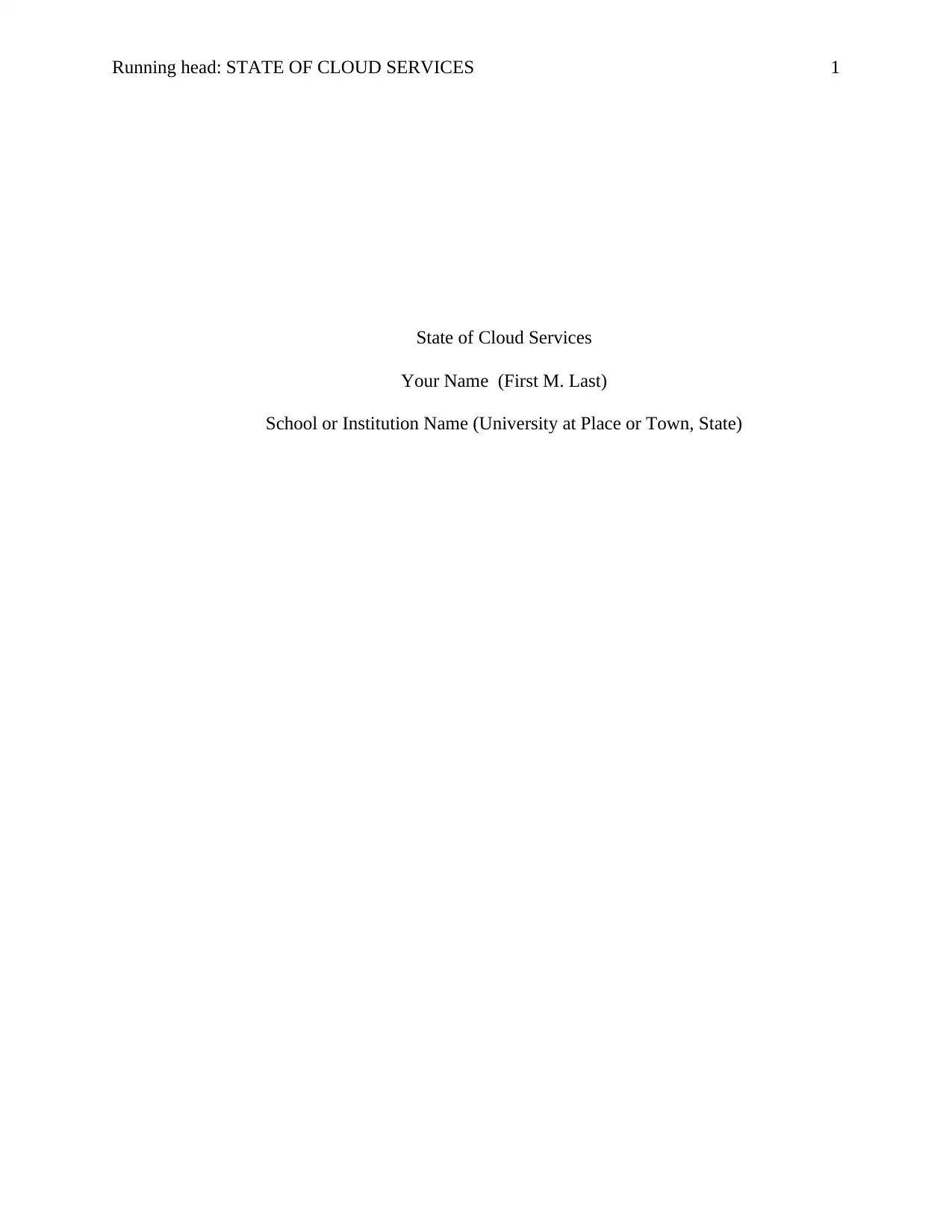
Running head: STATE OF CLOUD SERVICES
State of Cloud Services
Your Name (First M. Last)
School or Institution Name (University at Place or Town, State)
1
State of Cloud Services
Your Name (First M. Last)
School or Institution Name (University at Place or Town, State)
1
Paraphrase This Document
Need a fresh take? Get an instant paraphrase of this document with our AI Paraphraser
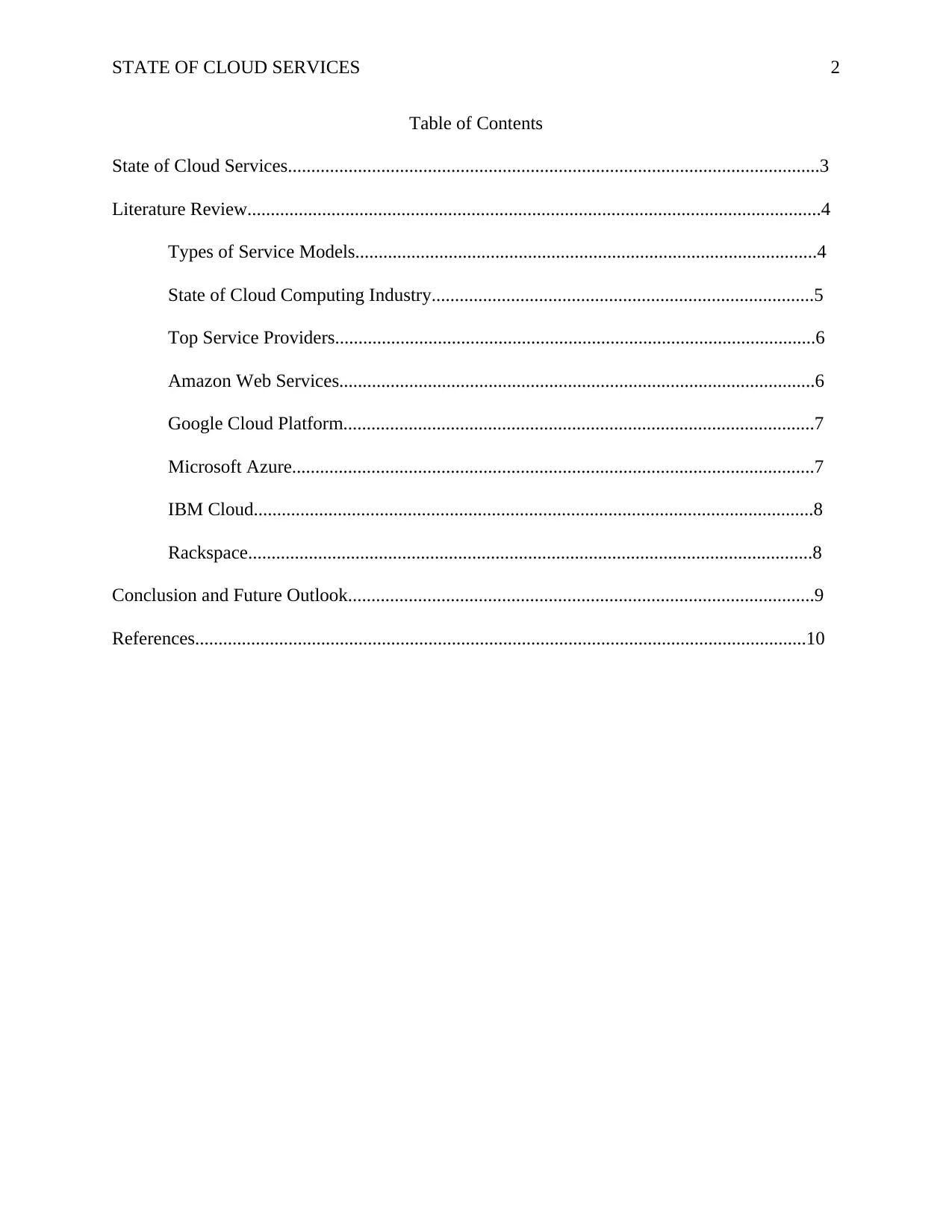
STATE OF CLOUD SERVICES
Table of Contents
State of Cloud Services..................................................................................................................3
Literature Review...........................................................................................................................4
Types of Service Models...................................................................................................4
State of Cloud Computing Industry..................................................................................5
Top Service Providers.......................................................................................................6
Amazon Web Services......................................................................................................6
Google Cloud Platform.....................................................................................................7
Microsoft Azure................................................................................................................7
IBM Cloud........................................................................................................................8
Rackspace.........................................................................................................................8
Conclusion and Future Outlook....................................................................................................9
References...................................................................................................................................10
2
Table of Contents
State of Cloud Services..................................................................................................................3
Literature Review...........................................................................................................................4
Types of Service Models...................................................................................................4
State of Cloud Computing Industry..................................................................................5
Top Service Providers.......................................................................................................6
Amazon Web Services......................................................................................................6
Google Cloud Platform.....................................................................................................7
Microsoft Azure................................................................................................................7
IBM Cloud........................................................................................................................8
Rackspace.........................................................................................................................8
Conclusion and Future Outlook....................................................................................................9
References...................................................................................................................................10
2

STATE OF CLOUD SERVICES
State of Cloud Services
Cloud computing is a buzzword of the Information Technology (IT) industry (Regalado,
2011) with even non-technical people and users using the term in common parlance. The term
was coined in 1996 and began gaining steam around 2006 when tech companies like Google and
Amazon began providing services which allowed users to access their data (like email and
documents) from any device using the Internet and describing them as "cloud computing"
(Regalado, 2011). Cloud computing is an older concept whose time has now come, technically
as well as commercially (Armbrust et al., 2009). Cloud computing has grown from distributed
computing, which is an orchestration of multiple computers which work together to solve a
single problem, bringing the processing and memory capabilities of each connected computer to
use for the common purpose for which they have been deployed (Coulouris, 2012). In contrast,
cloud computing is based on highly powerful machines in which multiple tenants (users of the
cloud service) reside using technologies like virtualisation (Hassan, 2011). The tenants use their
portion of the system for whatever purpose they desire. The resources at the disposal of each user
can grow or reduce (automatically) as per their demand.
As per the official standard by National Institute of Standards and Technology, USA
(Mell & Grance, 2011), Cloud computing is a generic term applicable to any system which
fulfils the following five essential characteristics:
On-demand self-service: The customer can help himself to manage his tenancy on the
cloud service without requiring any interaction with any staff of service provider. Also, the
customer can provision or release resources at will.
Broad network access: The services are used over a network that uses standard protocols
and encourages usage by all clients (thick or thin). Thick clients are powerful machines while
3
State of Cloud Services
Cloud computing is a buzzword of the Information Technology (IT) industry (Regalado,
2011) with even non-technical people and users using the term in common parlance. The term
was coined in 1996 and began gaining steam around 2006 when tech companies like Google and
Amazon began providing services which allowed users to access their data (like email and
documents) from any device using the Internet and describing them as "cloud computing"
(Regalado, 2011). Cloud computing is an older concept whose time has now come, technically
as well as commercially (Armbrust et al., 2009). Cloud computing has grown from distributed
computing, which is an orchestration of multiple computers which work together to solve a
single problem, bringing the processing and memory capabilities of each connected computer to
use for the common purpose for which they have been deployed (Coulouris, 2012). In contrast,
cloud computing is based on highly powerful machines in which multiple tenants (users of the
cloud service) reside using technologies like virtualisation (Hassan, 2011). The tenants use their
portion of the system for whatever purpose they desire. The resources at the disposal of each user
can grow or reduce (automatically) as per their demand.
As per the official standard by National Institute of Standards and Technology, USA
(Mell & Grance, 2011), Cloud computing is a generic term applicable to any system which
fulfils the following five essential characteristics:
On-demand self-service: The customer can help himself to manage his tenancy on the
cloud service without requiring any interaction with any staff of service provider. Also, the
customer can provision or release resources at will.
Broad network access: The services are used over a network that uses standard protocols
and encourages usage by all clients (thick or thin). Thick clients are powerful machines while
3
⊘ This is a preview!⊘
Do you want full access?
Subscribe today to unlock all pages.

Trusted by 1+ million students worldwide
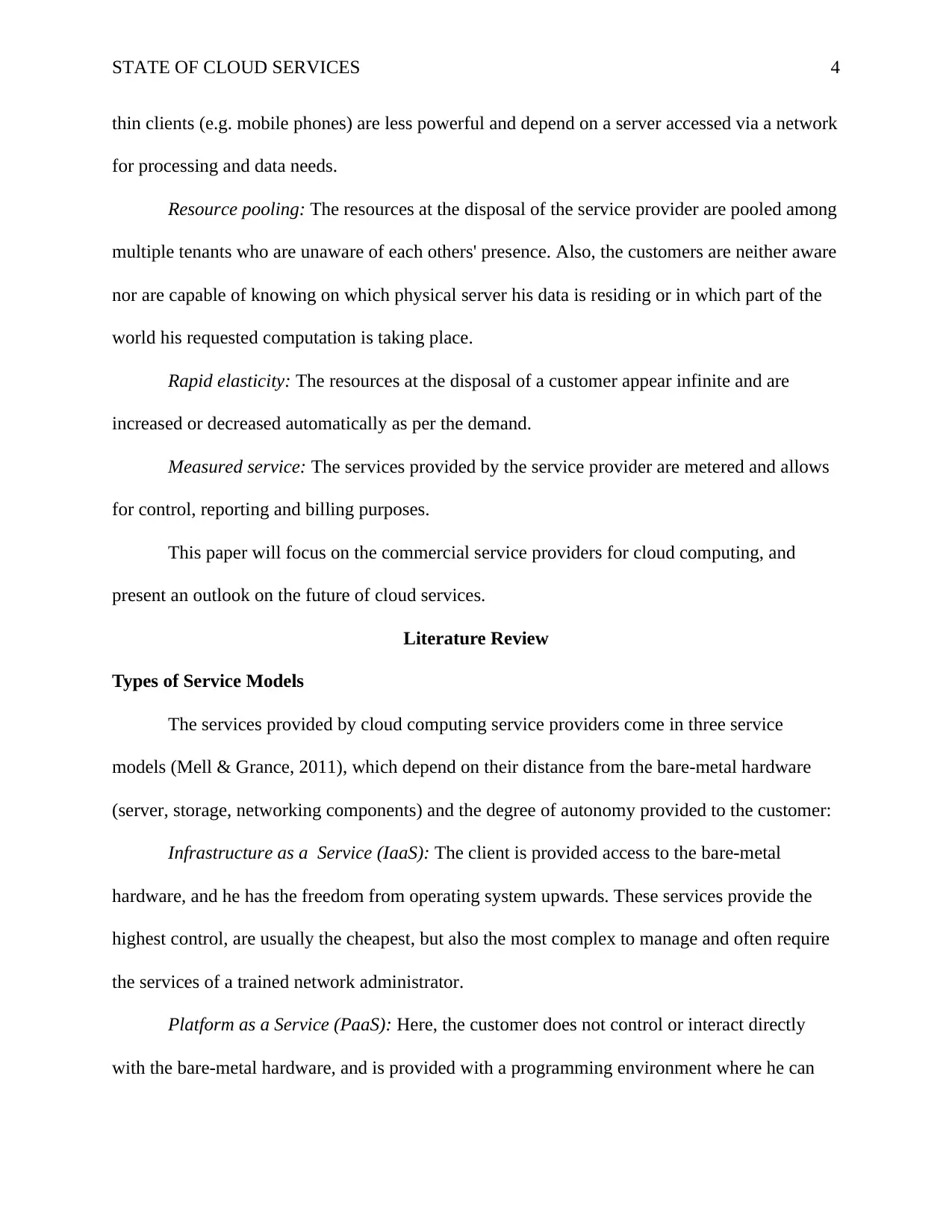
STATE OF CLOUD SERVICES
thin clients (e.g. mobile phones) are less powerful and depend on a server accessed via a network
for processing and data needs.
Resource pooling: The resources at the disposal of the service provider are pooled among
multiple tenants who are unaware of each others' presence. Also, the customers are neither aware
nor are capable of knowing on which physical server his data is residing or in which part of the
world his requested computation is taking place.
Rapid elasticity: The resources at the disposal of a customer appear infinite and are
increased or decreased automatically as per the demand.
Measured service: The services provided by the service provider are metered and allows
for control, reporting and billing purposes.
This paper will focus on the commercial service providers for cloud computing, and
present an outlook on the future of cloud services.
Literature Review
Types of Service Models
The services provided by cloud computing service providers come in three service
models (Mell & Grance, 2011), which depend on their distance from the bare-metal hardware
(server, storage, networking components) and the degree of autonomy provided to the customer:
Infrastructure as a Service (IaaS): The client is provided access to the bare-metal
hardware, and he has the freedom from operating system upwards. These services provide the
highest control, are usually the cheapest, but also the most complex to manage and often require
the services of a trained network administrator.
Platform as a Service (PaaS): Here, the customer does not control or interact directly
with the bare-metal hardware, and is provided with a programming environment where he can
4
thin clients (e.g. mobile phones) are less powerful and depend on a server accessed via a network
for processing and data needs.
Resource pooling: The resources at the disposal of the service provider are pooled among
multiple tenants who are unaware of each others' presence. Also, the customers are neither aware
nor are capable of knowing on which physical server his data is residing or in which part of the
world his requested computation is taking place.
Rapid elasticity: The resources at the disposal of a customer appear infinite and are
increased or decreased automatically as per the demand.
Measured service: The services provided by the service provider are metered and allows
for control, reporting and billing purposes.
This paper will focus on the commercial service providers for cloud computing, and
present an outlook on the future of cloud services.
Literature Review
Types of Service Models
The services provided by cloud computing service providers come in three service
models (Mell & Grance, 2011), which depend on their distance from the bare-metal hardware
(server, storage, networking components) and the degree of autonomy provided to the customer:
Infrastructure as a Service (IaaS): The client is provided access to the bare-metal
hardware, and he has the freedom from operating system upwards. These services provide the
highest control, are usually the cheapest, but also the most complex to manage and often require
the services of a trained network administrator.
Platform as a Service (PaaS): Here, the customer does not control or interact directly
with the bare-metal hardware, and is provided with a programming environment where he can
4
Paraphrase This Document
Need a fresh take? Get an instant paraphrase of this document with our AI Paraphraser
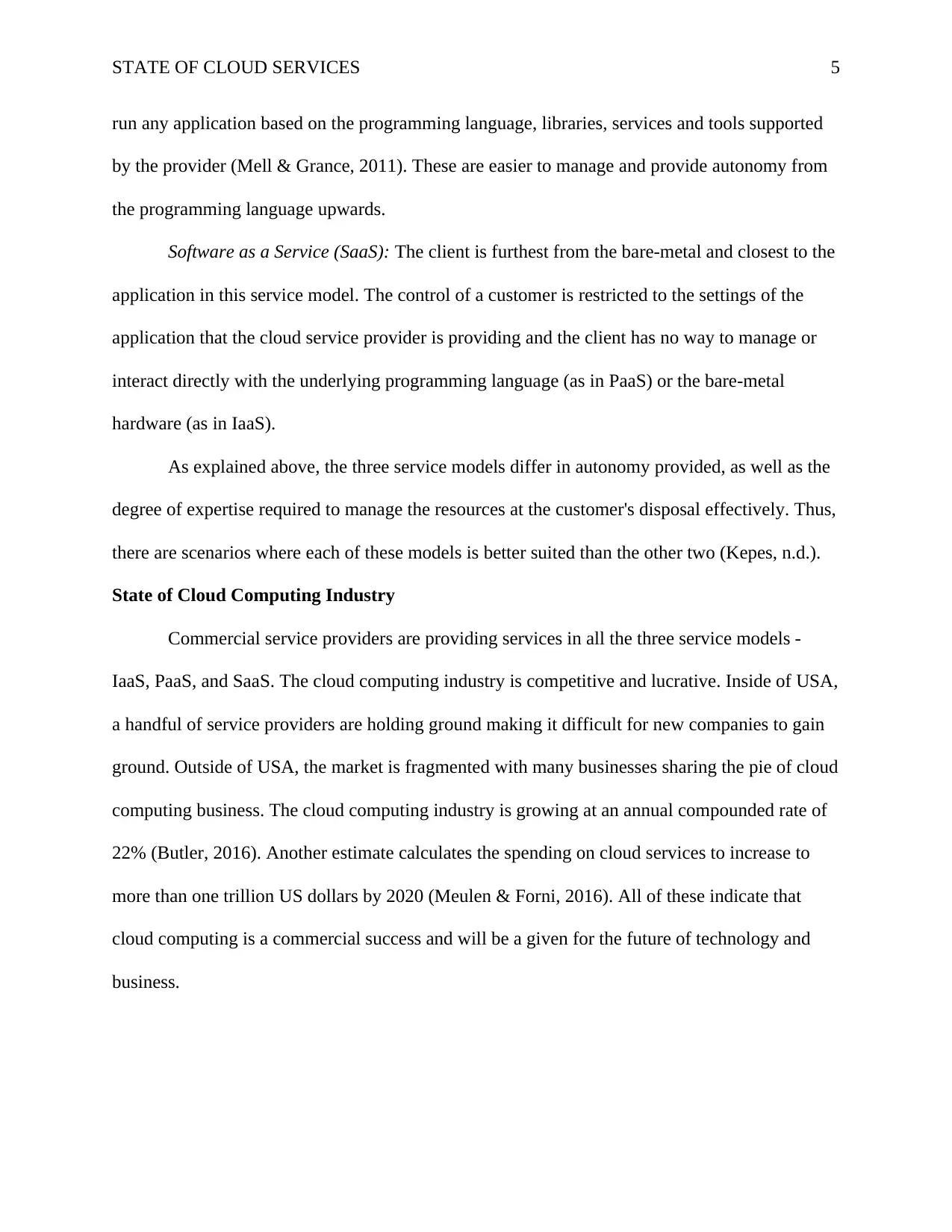
STATE OF CLOUD SERVICES
run any application based on the programming language, libraries, services and tools supported
by the provider (Mell & Grance, 2011). These are easier to manage and provide autonomy from
the programming language upwards.
Software as a Service (SaaS): The client is furthest from the bare-metal and closest to the
application in this service model. The control of a customer is restricted to the settings of the
application that the cloud service provider is providing and the client has no way to manage or
interact directly with the underlying programming language (as in PaaS) or the bare-metal
hardware (as in IaaS).
As explained above, the three service models differ in autonomy provided, as well as the
degree of expertise required to manage the resources at the customer's disposal effectively. Thus,
there are scenarios where each of these models is better suited than the other two (Kepes, n.d.).
State of Cloud Computing Industry
Commercial service providers are providing services in all the three service models -
IaaS, PaaS, and SaaS. The cloud computing industry is competitive and lucrative. Inside of USA,
a handful of service providers are holding ground making it difficult for new companies to gain
ground. Outside of USA, the market is fragmented with many businesses sharing the pie of cloud
computing business. The cloud computing industry is growing at an annual compounded rate of
22% (Butler, 2016). Another estimate calculates the spending on cloud services to increase to
more than one trillion US dollars by 2020 (Meulen & Forni, 2016). All of these indicate that
cloud computing is a commercial success and will be a given for the future of technology and
business.
5
run any application based on the programming language, libraries, services and tools supported
by the provider (Mell & Grance, 2011). These are easier to manage and provide autonomy from
the programming language upwards.
Software as a Service (SaaS): The client is furthest from the bare-metal and closest to the
application in this service model. The control of a customer is restricted to the settings of the
application that the cloud service provider is providing and the client has no way to manage or
interact directly with the underlying programming language (as in PaaS) or the bare-metal
hardware (as in IaaS).
As explained above, the three service models differ in autonomy provided, as well as the
degree of expertise required to manage the resources at the customer's disposal effectively. Thus,
there are scenarios where each of these models is better suited than the other two (Kepes, n.d.).
State of Cloud Computing Industry
Commercial service providers are providing services in all the three service models -
IaaS, PaaS, and SaaS. The cloud computing industry is competitive and lucrative. Inside of USA,
a handful of service providers are holding ground making it difficult for new companies to gain
ground. Outside of USA, the market is fragmented with many businesses sharing the pie of cloud
computing business. The cloud computing industry is growing at an annual compounded rate of
22% (Butler, 2016). Another estimate calculates the spending on cloud services to increase to
more than one trillion US dollars by 2020 (Meulen & Forni, 2016). All of these indicate that
cloud computing is a commercial success and will be a given for the future of technology and
business.
5
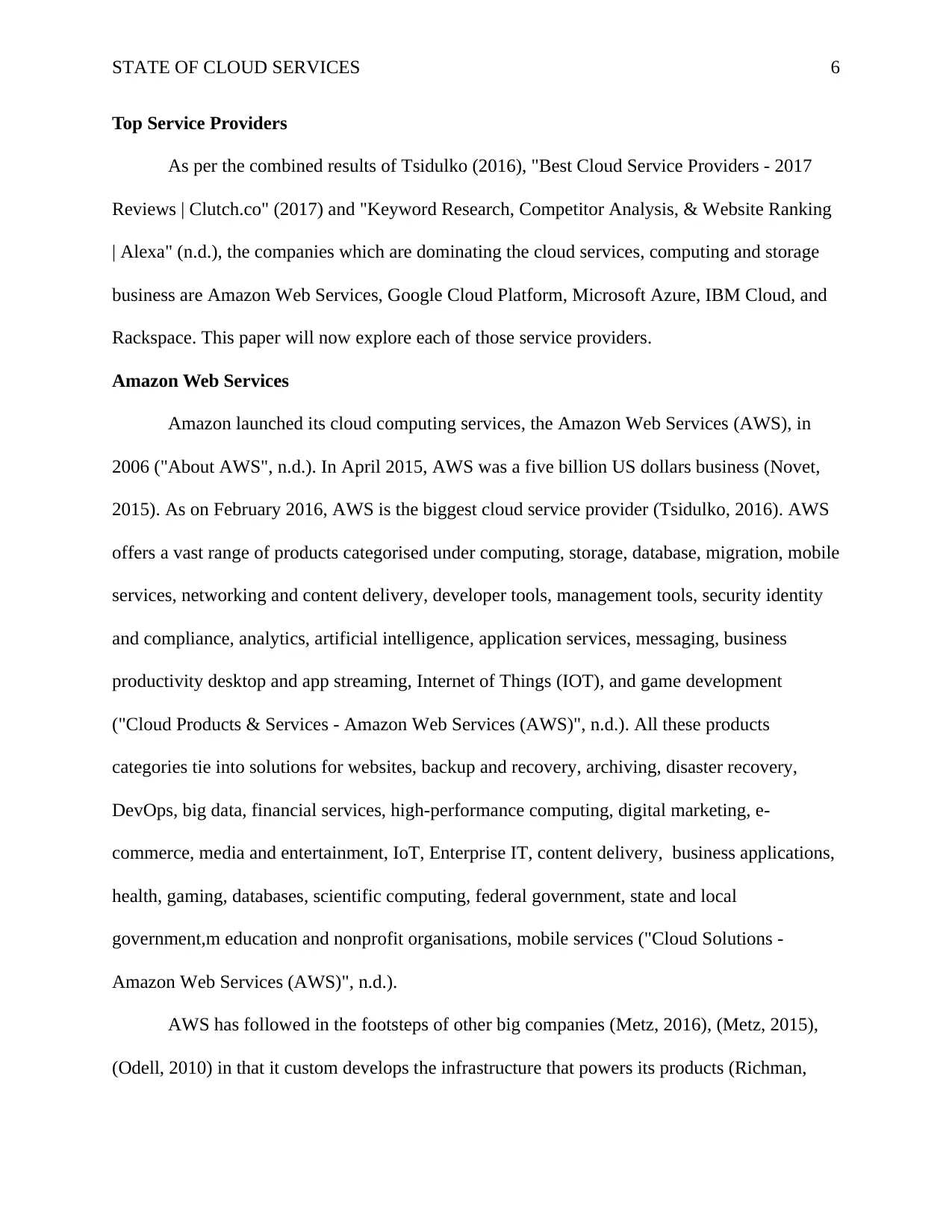
STATE OF CLOUD SERVICES
Top Service Providers
As per the combined results of Tsidulko (2016), "Best Cloud Service Providers - 2017
Reviews | Clutch.co" (2017) and "Keyword Research, Competitor Analysis, & Website Ranking
| Alexa" (n.d.), the companies which are dominating the cloud services, computing and storage
business are Amazon Web Services, Google Cloud Platform, Microsoft Azure, IBM Cloud, and
Rackspace. This paper will now explore each of those service providers.
Amazon Web Services
Amazon launched its cloud computing services, the Amazon Web Services (AWS), in
2006 ("About AWS", n.d.). In April 2015, AWS was a five billion US dollars business (Novet,
2015). As on February 2016, AWS is the biggest cloud service provider (Tsidulko, 2016). AWS
offers a vast range of products categorised under computing, storage, database, migration, mobile
services, networking and content delivery, developer tools, management tools, security identity
and compliance, analytics, artificial intelligence, application services, messaging, business
productivity desktop and app streaming, Internet of Things (IOT), and game development
("Cloud Products & Services - Amazon Web Services (AWS)", n.d.). All these products
categories tie into solutions for websites, backup and recovery, archiving, disaster recovery,
DevOps, big data, financial services, high-performance computing, digital marketing, e-
commerce, media and entertainment, IoT, Enterprise IT, content delivery, business applications,
health, gaming, databases, scientific computing, federal government, state and local
government,m education and nonprofit organisations, mobile services ("Cloud Solutions -
Amazon Web Services (AWS)", n.d.).
AWS has followed in the footsteps of other big companies (Metz, 2016), (Metz, 2015),
(Odell, 2010) in that it custom develops the infrastructure that powers its products (Richman,
6
Top Service Providers
As per the combined results of Tsidulko (2016), "Best Cloud Service Providers - 2017
Reviews | Clutch.co" (2017) and "Keyword Research, Competitor Analysis, & Website Ranking
| Alexa" (n.d.), the companies which are dominating the cloud services, computing and storage
business are Amazon Web Services, Google Cloud Platform, Microsoft Azure, IBM Cloud, and
Rackspace. This paper will now explore each of those service providers.
Amazon Web Services
Amazon launched its cloud computing services, the Amazon Web Services (AWS), in
2006 ("About AWS", n.d.). In April 2015, AWS was a five billion US dollars business (Novet,
2015). As on February 2016, AWS is the biggest cloud service provider (Tsidulko, 2016). AWS
offers a vast range of products categorised under computing, storage, database, migration, mobile
services, networking and content delivery, developer tools, management tools, security identity
and compliance, analytics, artificial intelligence, application services, messaging, business
productivity desktop and app streaming, Internet of Things (IOT), and game development
("Cloud Products & Services - Amazon Web Services (AWS)", n.d.). All these products
categories tie into solutions for websites, backup and recovery, archiving, disaster recovery,
DevOps, big data, financial services, high-performance computing, digital marketing, e-
commerce, media and entertainment, IoT, Enterprise IT, content delivery, business applications,
health, gaming, databases, scientific computing, federal government, state and local
government,m education and nonprofit organisations, mobile services ("Cloud Solutions -
Amazon Web Services (AWS)", n.d.).
AWS has followed in the footsteps of other big companies (Metz, 2016), (Metz, 2015),
(Odell, 2010) in that it custom develops the infrastructure that powers its products (Richman,
6
⊘ This is a preview!⊘
Do you want full access?
Subscribe today to unlock all pages.

Trusted by 1+ million students worldwide
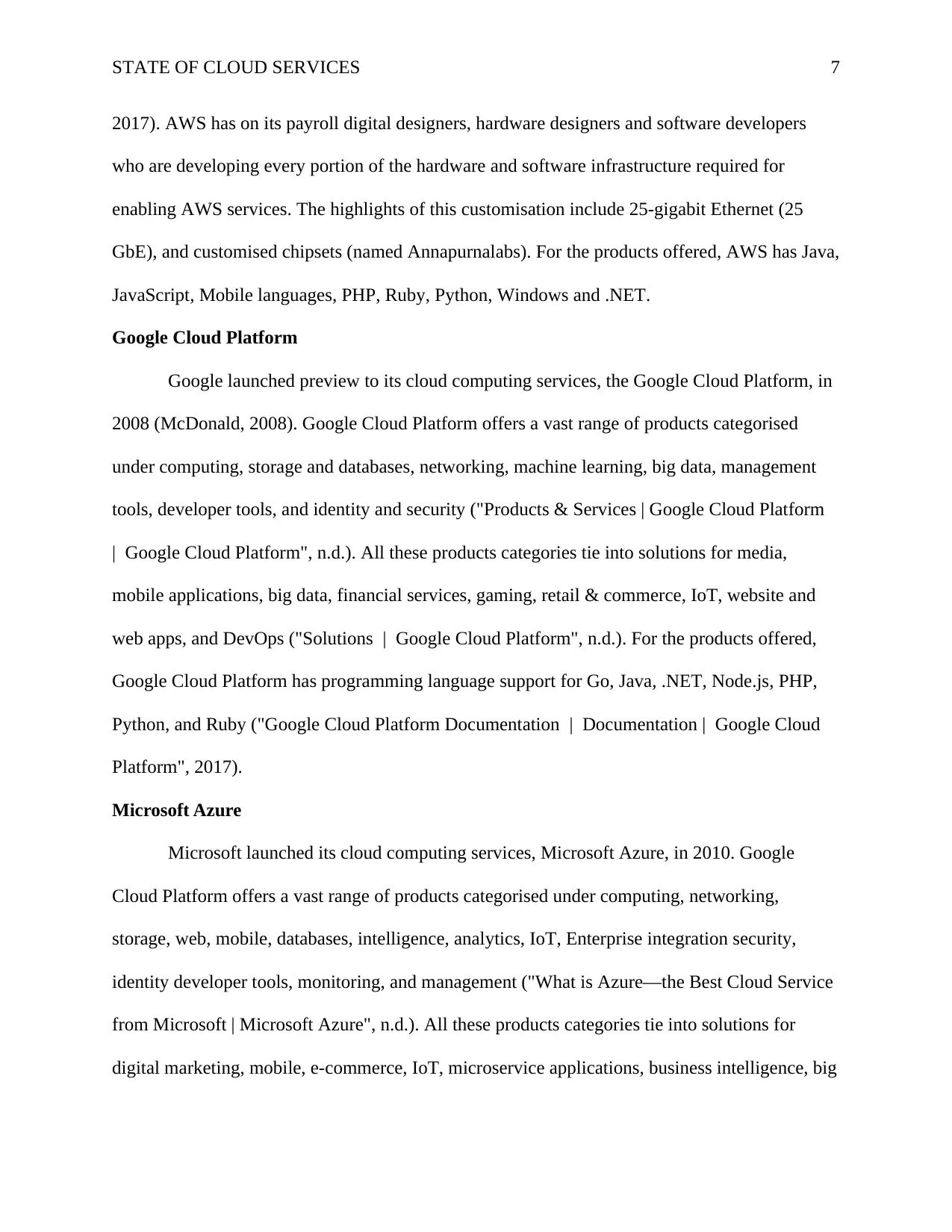
STATE OF CLOUD SERVICES
2017). AWS has on its payroll digital designers, hardware designers and software developers
who are developing every portion of the hardware and software infrastructure required for
enabling AWS services. The highlights of this customisation include 25-gigabit Ethernet (25
GbE), and customised chipsets (named Annapurnalabs). For the products offered, AWS has Java,
JavaScript, Mobile languages, PHP, Ruby, Python, Windows and .NET.
Google Cloud Platform
Google launched preview to its cloud computing services, the Google Cloud Platform, in
2008 (McDonald, 2008). Google Cloud Platform offers a vast range of products categorised
under computing, storage and databases, networking, machine learning, big data, management
tools, developer tools, and identity and security ("Products & Services | Google Cloud Platform
| Google Cloud Platform", n.d.). All these products categories tie into solutions for media,
mobile applications, big data, financial services, gaming, retail & commerce, IoT, website and
web apps, and DevOps ("Solutions | Google Cloud Platform", n.d.). For the products offered,
Google Cloud Platform has programming language support for Go, Java, .NET, Node.js, PHP,
Python, and Ruby ("Google Cloud Platform Documentation | Documentation | Google Cloud
Platform", 2017).
Microsoft Azure
Microsoft launched its cloud computing services, Microsoft Azure, in 2010. Google
Cloud Platform offers a vast range of products categorised under computing, networking,
storage, web, mobile, databases, intelligence, analytics, IoT, Enterprise integration security,
identity developer tools, monitoring, and management ("What is Azure—the Best Cloud Service
from Microsoft | Microsoft Azure", n.d.). All these products categories tie into solutions for
digital marketing, mobile, e-commerce, IoT, microservice applications, business intelligence, big
7
2017). AWS has on its payroll digital designers, hardware designers and software developers
who are developing every portion of the hardware and software infrastructure required for
enabling AWS services. The highlights of this customisation include 25-gigabit Ethernet (25
GbE), and customised chipsets (named Annapurnalabs). For the products offered, AWS has Java,
JavaScript, Mobile languages, PHP, Ruby, Python, Windows and .NET.
Google Cloud Platform
Google launched preview to its cloud computing services, the Google Cloud Platform, in
2008 (McDonald, 2008). Google Cloud Platform offers a vast range of products categorised
under computing, storage and databases, networking, machine learning, big data, management
tools, developer tools, and identity and security ("Products & Services | Google Cloud Platform
| Google Cloud Platform", n.d.). All these products categories tie into solutions for media,
mobile applications, big data, financial services, gaming, retail & commerce, IoT, website and
web apps, and DevOps ("Solutions | Google Cloud Platform", n.d.). For the products offered,
Google Cloud Platform has programming language support for Go, Java, .NET, Node.js, PHP,
Python, and Ruby ("Google Cloud Platform Documentation | Documentation | Google Cloud
Platform", 2017).
Microsoft Azure
Microsoft launched its cloud computing services, Microsoft Azure, in 2010. Google
Cloud Platform offers a vast range of products categorised under computing, networking,
storage, web, mobile, databases, intelligence, analytics, IoT, Enterprise integration security,
identity developer tools, monitoring, and management ("What is Azure—the Best Cloud Service
from Microsoft | Microsoft Azure", n.d.). All these products categories tie into solutions for
digital marketing, mobile, e-commerce, IoT, microservice applications, business intelligence, big
7
Paraphrase This Document
Need a fresh take? Get an instant paraphrase of this document with our AI Paraphraser

STATE OF CLOUD SERVICES
data, analytics, data warehousing, business SaaS apps, backup and archive, development and test,
disaster recovery, hybrid integration, SAP, Sharepoint, Dynamics, high-performance computing,
digital media, gaming, and blockchain ("Azure solutions | Microsoft Azure", n.d.).
IBM Cloud
IBM Cloud offers a vast range of products categorised under computing, data and
analytics, application platform, hybrid integration, storage, DevOps, mobile, high-speed transfer,
data sets, streaming video, security, cloud management, business process management,
blockchain. All these products categories tie into solutions for cognitive business operations,
cognitive solutions, developer solutions, high-performance computing, marketing, SaaS
migration, VMware solutions, video solutions ("IBM - Cloud Computing for Builders &
Innovators", n.d.). One of the differentiating features of IBM cloud is the business intelligence
using their Cognitive line of products ("IBM Cognitive", n.d.) which allows a customer to extract
knowledge from their data programmatically. They provide an example where searching for
"anything that's not an elephant" on search engines would provide in results of elephants, but the
Cognitive line of products understands such nuances.
Rackspace
Rackspace Cloud is a PaaS service where the chosen IaaS service is managed on behalf
of the customer. Rackspace Cloud provides skilled personnel to its clients who then manage the
underlying services. The basic services it supports are AWS, Microsoft Azure, VMware and
OpenStack Cloud. Also, the deployment models supported are public cloud, private cloud,
hybrid cloud and multi-cloud ("Choosing a Cloud Platform | Managed Cloud by Rackspace",
n.d.). Multi-cloud is an emerging trend which aims to mitigate the single-point-of-failure by
depending on a single cloud service provider ("What is Multi-Cloud? | Using Multiple Cloud
8
data, analytics, data warehousing, business SaaS apps, backup and archive, development and test,
disaster recovery, hybrid integration, SAP, Sharepoint, Dynamics, high-performance computing,
digital media, gaming, and blockchain ("Azure solutions | Microsoft Azure", n.d.).
IBM Cloud
IBM Cloud offers a vast range of products categorised under computing, data and
analytics, application platform, hybrid integration, storage, DevOps, mobile, high-speed transfer,
data sets, streaming video, security, cloud management, business process management,
blockchain. All these products categories tie into solutions for cognitive business operations,
cognitive solutions, developer solutions, high-performance computing, marketing, SaaS
migration, VMware solutions, video solutions ("IBM - Cloud Computing for Builders &
Innovators", n.d.). One of the differentiating features of IBM cloud is the business intelligence
using their Cognitive line of products ("IBM Cognitive", n.d.) which allows a customer to extract
knowledge from their data programmatically. They provide an example where searching for
"anything that's not an elephant" on search engines would provide in results of elephants, but the
Cognitive line of products understands such nuances.
Rackspace
Rackspace Cloud is a PaaS service where the chosen IaaS service is managed on behalf
of the customer. Rackspace Cloud provides skilled personnel to its clients who then manage the
underlying services. The basic services it supports are AWS, Microsoft Azure, VMware and
OpenStack Cloud. Also, the deployment models supported are public cloud, private cloud,
hybrid cloud and multi-cloud ("Choosing a Cloud Platform | Managed Cloud by Rackspace",
n.d.). Multi-cloud is an emerging trend which aims to mitigate the single-point-of-failure by
depending on a single cloud service provider ("What is Multi-Cloud? | Using Multiple Cloud
8

STATE OF CLOUD SERVICES
Providers", n.d.). The infrastructure they support includes dedicated hosting, computing,
networking, storage, infrastructure and developer tools, database and data analytics, email
hosting, and simple websites. Support for these infrastructure enables Rackspace Cloud to
provide products in e-commerce, security and email hosting, compliance, data services,
productivity and collaboration, web content management, the web and mobile apps and managed
services for digital apps.
Conclusion and Future Outlook
As we have seen in this paper, cloud services are ubiquitous now and ignoring them is
not a wise business or technical move. The concept of cloud computing has been imagined by
researchers from decades, but it is only due to cheap processing power, increasing network
capacities and the consumer demand that computing (processing, storage, intelligence from
customer's data) is now a utility. Review of the literature and the marketplace suggests that all
three service models are being exploited by companies to offer varying products for clients
which different requirements. In the USA, a handful of businesses has entrenched themselves
and this makes it difficult for newcomers to gain ground. Outside of USA, however, the market
is fragmented, and there is no clear winner regarding global market share yet.
Also, cloud services are becoming secure with companies choosing to move their
confidential health records (which are constrained to strict HIPAA laws ("Health Information
Privacy", n.d.)) online. Techniques like encryption help comply with HIPAA regulations. US
Army is contracting to a private cloud services provider for a contract estimated to be worth 62
billion US dollars (Condon, 2017). Game-changing companies like Netflix, Tinder, and Airbnb
are using the same cloud service provider to host their entire business (Williams, 2015). All this
indicates the commercial and government approval for cloud technologies. The future of cloud
9
Providers", n.d.). The infrastructure they support includes dedicated hosting, computing,
networking, storage, infrastructure and developer tools, database and data analytics, email
hosting, and simple websites. Support for these infrastructure enables Rackspace Cloud to
provide products in e-commerce, security and email hosting, compliance, data services,
productivity and collaboration, web content management, the web and mobile apps and managed
services for digital apps.
Conclusion and Future Outlook
As we have seen in this paper, cloud services are ubiquitous now and ignoring them is
not a wise business or technical move. The concept of cloud computing has been imagined by
researchers from decades, but it is only due to cheap processing power, increasing network
capacities and the consumer demand that computing (processing, storage, intelligence from
customer's data) is now a utility. Review of the literature and the marketplace suggests that all
three service models are being exploited by companies to offer varying products for clients
which different requirements. In the USA, a handful of businesses has entrenched themselves
and this makes it difficult for newcomers to gain ground. Outside of USA, however, the market
is fragmented, and there is no clear winner regarding global market share yet.
Also, cloud services are becoming secure with companies choosing to move their
confidential health records (which are constrained to strict HIPAA laws ("Health Information
Privacy", n.d.)) online. Techniques like encryption help comply with HIPAA regulations. US
Army is contracting to a private cloud services provider for a contract estimated to be worth 62
billion US dollars (Condon, 2017). Game-changing companies like Netflix, Tinder, and Airbnb
are using the same cloud service provider to host their entire business (Williams, 2015). All this
indicates the commercial and government approval for cloud technologies. The future of cloud
9
⊘ This is a preview!⊘
Do you want full access?
Subscribe today to unlock all pages.

Trusted by 1+ million students worldwide
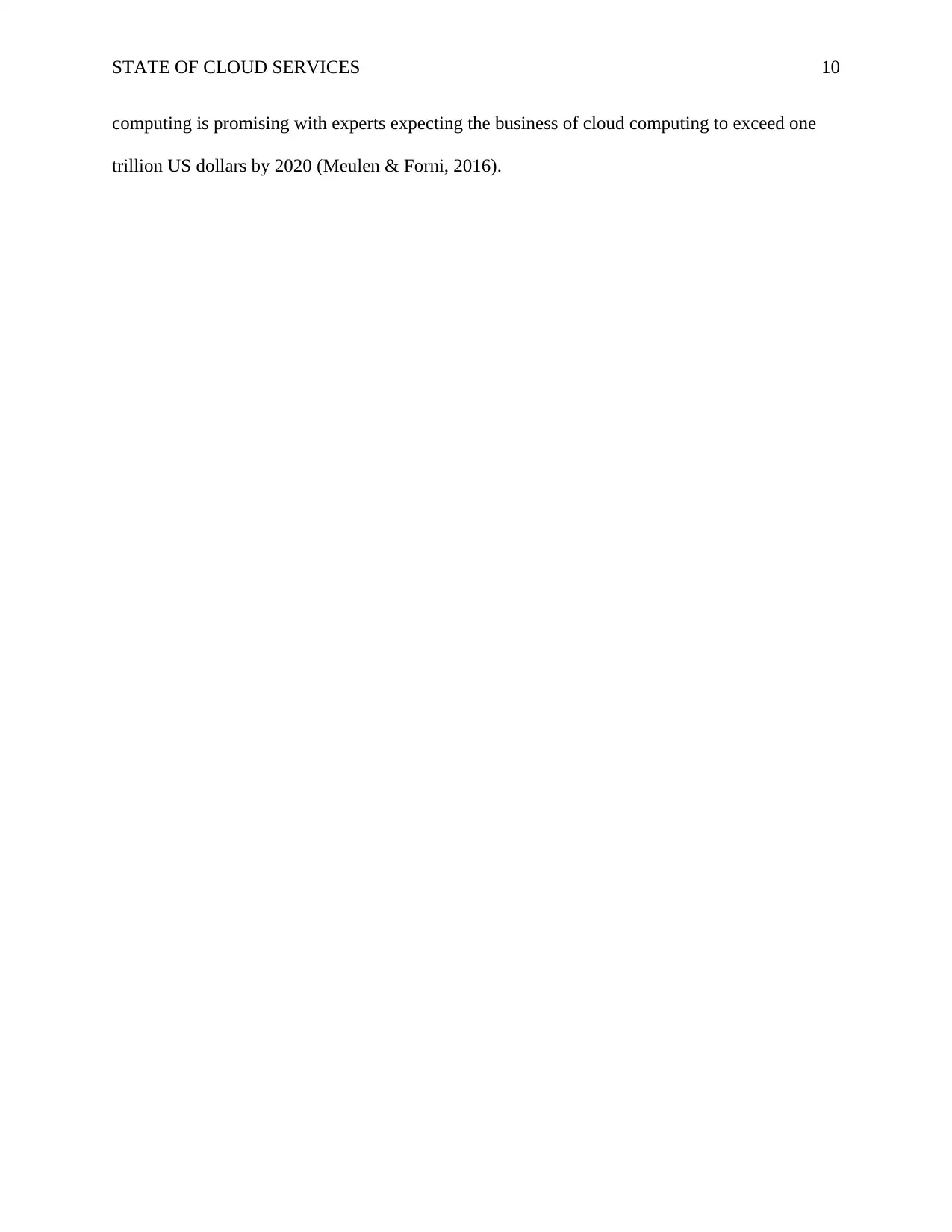
STATE OF CLOUD SERVICES
computing is promising with experts expecting the business of cloud computing to exceed one
trillion US dollars by 2020 (Meulen & Forni, 2016).
10
computing is promising with experts expecting the business of cloud computing to exceed one
trillion US dollars by 2020 (Meulen & Forni, 2016).
10
Paraphrase This Document
Need a fresh take? Get an instant paraphrase of this document with our AI Paraphraser
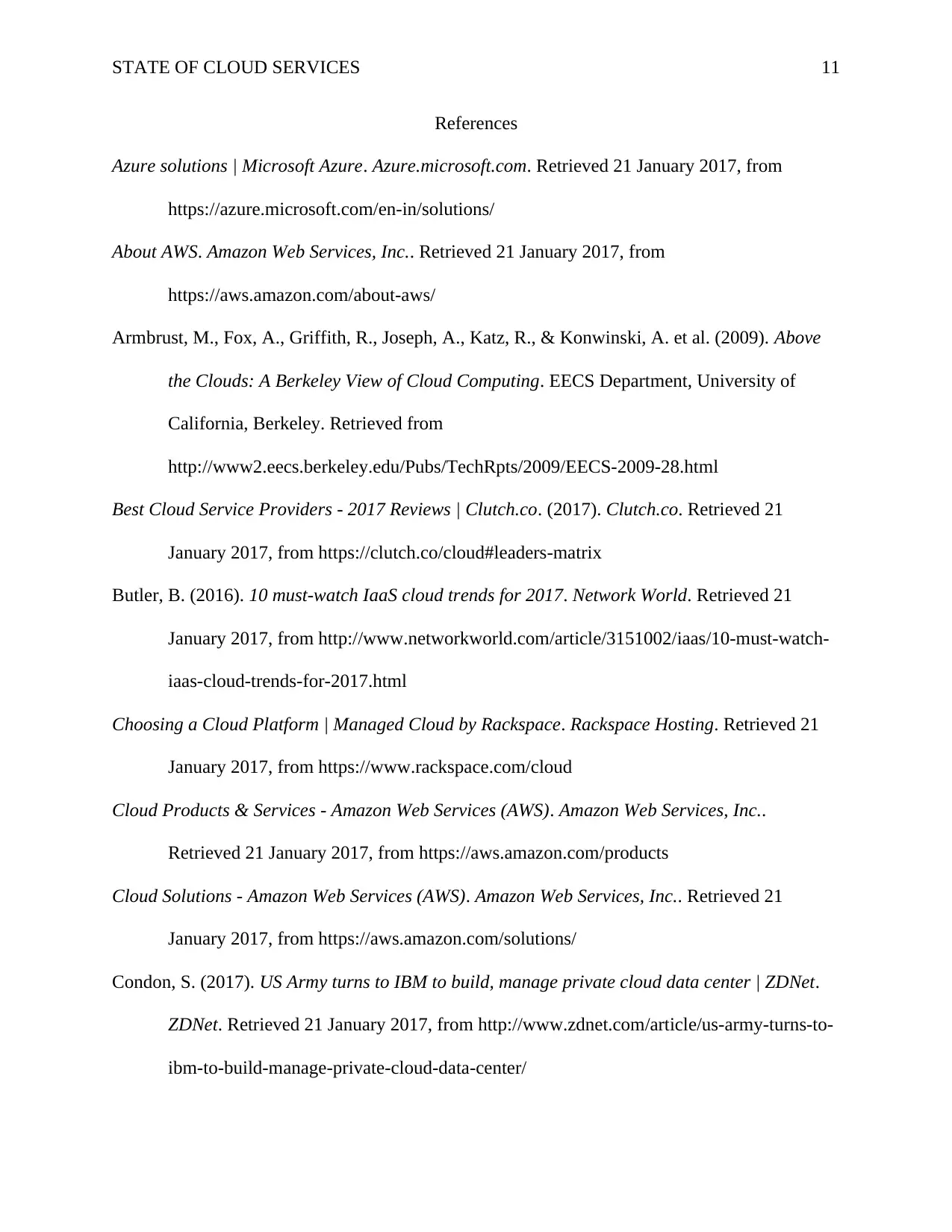
STATE OF CLOUD SERVICES
References
Azure solutions | Microsoft Azure. Azure.microsoft.com. Retrieved 21 January 2017, from
https://azure.microsoft.com/en-in/solutions/
About AWS. Amazon Web Services, Inc.. Retrieved 21 January 2017, from
https://aws.amazon.com/about-aws/
Armbrust, M., Fox, A., Griffith, R., Joseph, A., Katz, R., & Konwinski, A. et al. (2009). Above
the Clouds: A Berkeley View of Cloud Computing. EECS Department, University of
California, Berkeley. Retrieved from
http://www2.eecs.berkeley.edu/Pubs/TechRpts/2009/EECS-2009-28.html
Best Cloud Service Providers - 2017 Reviews | Clutch.co. (2017). Clutch.co. Retrieved 21
January 2017, from https://clutch.co/cloud#leaders-matrix
Butler, B. (2016). 10 must-watch IaaS cloud trends for 2017. Network World. Retrieved 21
January 2017, from http://www.networkworld.com/article/3151002/iaas/10-must-watch-
iaas-cloud-trends-for-2017.html
Choosing a Cloud Platform | Managed Cloud by Rackspace. Rackspace Hosting. Retrieved 21
January 2017, from https://www.rackspace.com/cloud
Cloud Products & Services - Amazon Web Services (AWS). Amazon Web Services, Inc..
Retrieved 21 January 2017, from https://aws.amazon.com/products
Cloud Solutions - Amazon Web Services (AWS). Amazon Web Services, Inc.. Retrieved 21
January 2017, from https://aws.amazon.com/solutions/
Condon, S. (2017). US Army turns to IBM to build, manage private cloud data center | ZDNet.
ZDNet. Retrieved 21 January 2017, from http://www.zdnet.com/article/us-army-turns-to-
ibm-to-build-manage-private-cloud-data-center/
11
References
Azure solutions | Microsoft Azure. Azure.microsoft.com. Retrieved 21 January 2017, from
https://azure.microsoft.com/en-in/solutions/
About AWS. Amazon Web Services, Inc.. Retrieved 21 January 2017, from
https://aws.amazon.com/about-aws/
Armbrust, M., Fox, A., Griffith, R., Joseph, A., Katz, R., & Konwinski, A. et al. (2009). Above
the Clouds: A Berkeley View of Cloud Computing. EECS Department, University of
California, Berkeley. Retrieved from
http://www2.eecs.berkeley.edu/Pubs/TechRpts/2009/EECS-2009-28.html
Best Cloud Service Providers - 2017 Reviews | Clutch.co. (2017). Clutch.co. Retrieved 21
January 2017, from https://clutch.co/cloud#leaders-matrix
Butler, B. (2016). 10 must-watch IaaS cloud trends for 2017. Network World. Retrieved 21
January 2017, from http://www.networkworld.com/article/3151002/iaas/10-must-watch-
iaas-cloud-trends-for-2017.html
Choosing a Cloud Platform | Managed Cloud by Rackspace. Rackspace Hosting. Retrieved 21
January 2017, from https://www.rackspace.com/cloud
Cloud Products & Services - Amazon Web Services (AWS). Amazon Web Services, Inc..
Retrieved 21 January 2017, from https://aws.amazon.com/products
Cloud Solutions - Amazon Web Services (AWS). Amazon Web Services, Inc.. Retrieved 21
January 2017, from https://aws.amazon.com/solutions/
Condon, S. (2017). US Army turns to IBM to build, manage private cloud data center | ZDNet.
ZDNet. Retrieved 21 January 2017, from http://www.zdnet.com/article/us-army-turns-to-
ibm-to-build-manage-private-cloud-data-center/
11

STATE OF CLOUD SERVICES
Coulouris, G. (2012). Distributed systems (1st ed.). Boston: Addison-Wesley.
Google Cloud Platform Documentation | Documentation | Google Cloud Platform. (2017).
Google Cloud Platform. Retrieved 21 January 2017, from https://cloud.google.com/docs/
Hassan, Q. (2011). Demystifying Cloud Computing (1st ed.). CrossTalk. Retrieved from
http://static1.1.sqspcdn.com/static/f/702523/10181434/1294788395300/201101-
Hassan.pdf?token=5xYLjCzse9SI3MNoUUuO2KmYkw8%3D
Health Information Privacy. HHS.gov. Retrieved 21 January 2017, from
https://www.hhs.gov/hipaa/
IBM - Cloud Computing for Builders & Innovators. Ibm.com. Retrieved 21 January 2017, from
https://www.ibm.com/cloud-computing/
IBM Cognitive. IBM. Retrieved 21 January 2017, from https://www.ibm.com/cognitive/
Kepes, B. Understanding the Cloud Computing Stack: SaaS, PaaS, IaaS. Rackspace Support
Network. Retrieved 21 January 2017, from
https://support.rackspace.com/white-paper/understanding-the-cloud-computing-stack-
saas-paas-iaas/
http://www.alexa.com/
Keyword Research, Competitor Analysis, & Website Ranking | Alexa. Alexa Internet. Retrieved
21 January 2017, from http://www.alexa.com/
McDonald, P. (2008). Introducing Google App Engine + our new blog. Google App Engine
Blog. Retrieved 21 January 2017, from
http://googleappengine.blogspot.in/2008/04/introducing-google-app-engine-our-new.html
12
Coulouris, G. (2012). Distributed systems (1st ed.). Boston: Addison-Wesley.
Google Cloud Platform Documentation | Documentation | Google Cloud Platform. (2017).
Google Cloud Platform. Retrieved 21 January 2017, from https://cloud.google.com/docs/
Hassan, Q. (2011). Demystifying Cloud Computing (1st ed.). CrossTalk. Retrieved from
http://static1.1.sqspcdn.com/static/f/702523/10181434/1294788395300/201101-
Hassan.pdf?token=5xYLjCzse9SI3MNoUUuO2KmYkw8%3D
Health Information Privacy. HHS.gov. Retrieved 21 January 2017, from
https://www.hhs.gov/hipaa/
IBM - Cloud Computing for Builders & Innovators. Ibm.com. Retrieved 21 January 2017, from
https://www.ibm.com/cloud-computing/
IBM Cognitive. IBM. Retrieved 21 January 2017, from https://www.ibm.com/cognitive/
Kepes, B. Understanding the Cloud Computing Stack: SaaS, PaaS, IaaS. Rackspace Support
Network. Retrieved 21 January 2017, from
https://support.rackspace.com/white-paper/understanding-the-cloud-computing-stack-
saas-paas-iaas/
http://www.alexa.com/
Keyword Research, Competitor Analysis, & Website Ranking | Alexa. Alexa Internet. Retrieved
21 January 2017, from http://www.alexa.com/
McDonald, P. (2008). Introducing Google App Engine + our new blog. Google App Engine
Blog. Retrieved 21 January 2017, from
http://googleappengine.blogspot.in/2008/04/introducing-google-app-engine-our-new.html
12
⊘ This is a preview!⊘
Do you want full access?
Subscribe today to unlock all pages.

Trusted by 1+ million students worldwide
1 out of 14
Related Documents
Your All-in-One AI-Powered Toolkit for Academic Success.
+13062052269
info@desklib.com
Available 24*7 on WhatsApp / Email
![[object Object]](/_next/static/media/star-bottom.7253800d.svg)
Unlock your academic potential
Copyright © 2020–2025 A2Z Services. All Rights Reserved. Developed and managed by ZUCOL.




